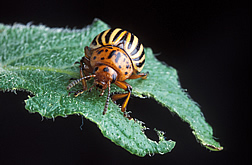This page has been archived and is being provided for reference purposes only. The page is no longer being updated, and therefore, links on the page may be invalid.
|
|
DNA Fingerprints for Insects
By Sharon DurhamSeptember 26, 2005
Using genetic fingerprinting, Agricultural Research Service (ARS) scientists have developed a method to identify immature forms of beneficial insects that could help control the pesky Colorado potato beetle.
Scientists have difficulty identifying immature forms of beneficial predators because they look so different from adults--and most identification guides are based on adult forms.
Now scientists at the ARS Insect Biocontrol Laboratory in Beltsville, Md., have developed DNA fingerprinting tools that match the immature predators to adults that have been positively identified.
Led by entomologist and research leader Matthew Greenstone, the group first demonstrated that these techniques can be applied to agriculturally important spider and ground beetle species, in a paper published in the September 2005 issue of the journal Molecular Ecology.
These techniques will be of immediate value to scientists, whose findings will then be used by extension personnel and consultants to advise growers on how to preserve and foster the most important predatory species.
Biological control--the management of pests by killing them with beneficial organisms, like predatoratory and parasitic insects--is a major alternative to control with chemical pesticides. Spiders and predatory insects play a major role in biological control of insect pests. Understanding their role is hampered by the inability to identify their immature forms.
ARS is the U.S. Department of Agriculture's chief scientific research agency.

